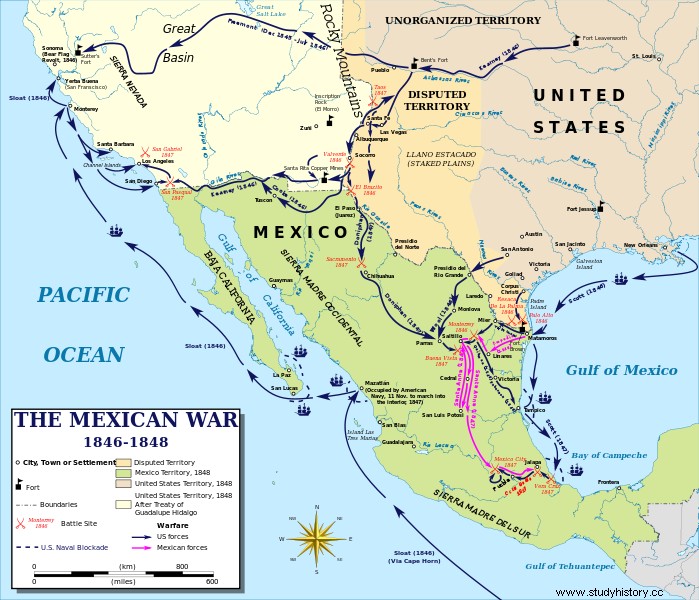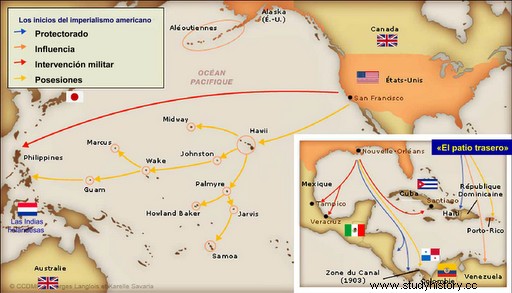US imperialism was a slightly different phenomenon from Europe. In the first place because their objectives were found, in principle, in the same continent and secondly because their interests were more strategic and political than economic.
These interests were defined around some ideological and strategic conceptions:
- The Monroe Doctrine (1823) which proposed the exclusion of American territories from any European colonial rule. Beneath its anti-imperialist appearance was the US interest in reserving for itself the ability to influence and control the Central American and Caribbean area, at a time when the Spanish Empire was crumbling.
- The doctrine of Manifest Destiny which proposed the idea that the North American people (of Protestant and Anglo-Saxon origin) had been chosen by God to raise the condition of humanity, which gave them the right to exercise their dominion over other peoples and territories, because this choice implied the recognition of his superiority.
- The doctrine of Admiral Alfred T. Mahan, in favor of extending North American dominance through a strategy of maritime control through the creation of naval bases and war fleets. This control would first affect the waters near the American territory -Gulf of Mexico and the Pacific- and then extend it to the main international maritime routes.
- The Roosevelt Corollary, proposed in 1904 by President Theodore Roosevelt. This ideology revised the Monroe Doctrine proposing the right to intervene in the internal affairs of Latin American countries when the political or economic interests of the United States or its citizens and companies were in danger.
The first phase of its expansion was what we call "the conquest of the west", a process that would lead it to confront Mexico in a war (1846-1848) that gave it immense territories as far as the Pacific (see attached map 1). At the same time, the indigenous population, the "Indians", was being numerically reduced and geographically concentrated in the so-called reserves.
 Map 1. Source:Wikipedia. Mexican–American War
Map 1. Source:Wikipedia. Mexican–American WarThe second phase focused on its hegemonic domination of the Caribbean and its claim to dominate the Pacific. In this, his intervention in the Spanish-Cuban war had a crucial importance; the Spanish defeat gave it the cession of the Philippines and Guam, as well as control of Cuba, nominally independent, and of Puerto Rico, which remained under direct political control of the United States. The process would be completed with the purchase of Alaska (1867 ) and the annexation of Hawaii (1898) (map 2).
 Map 2. Source:Contemporary World History . Ed. Santillana (2008)
Map 2. Source:Contemporary World History . Ed. Santillana (2008) The next step was military and political interventionism in the Caribbean area. Few were the countries in the area that got rid of it. This area became the springboard for its projection towards the rest of Latin America. Map 3 shows the intensity of this phenomenon.
 Map 3. Source:http://www.unc.edu/courses/2009fall/hist/140/ 006/Outlines/14.LatinAmerica.htm
Map 3. Source:http://www.unc.edu/courses/2009fall/hist/140/ 006/Outlines/14.LatinAmerica.htmAnother interesting cartographic contribution to the subject is provided by Julián Rodríguez Domínguez and Julián Rodriguez Gavilán.

